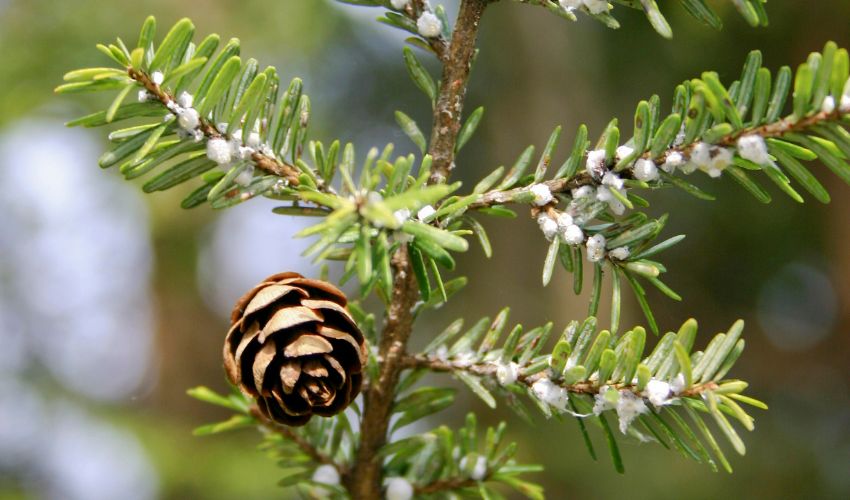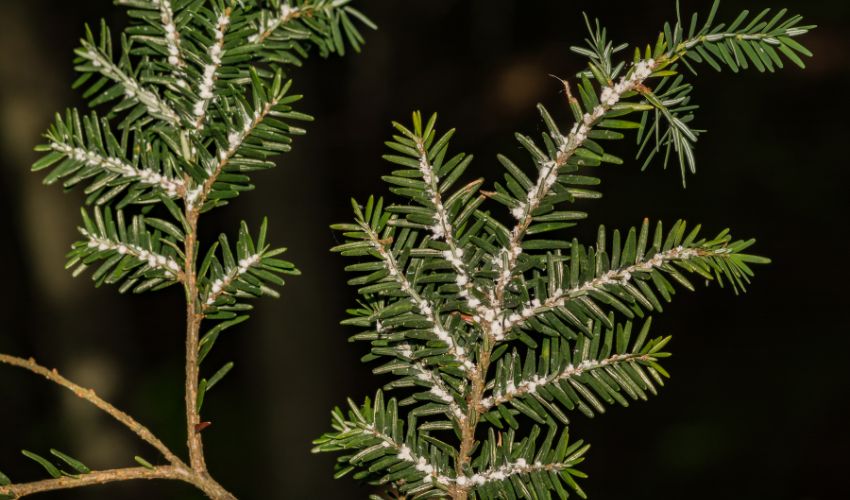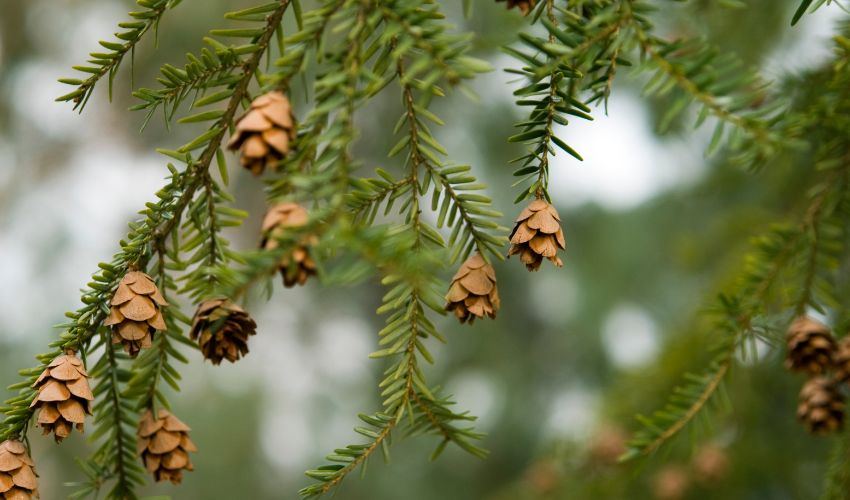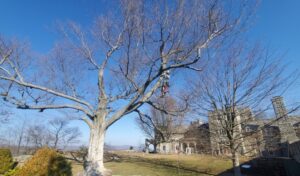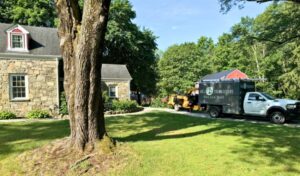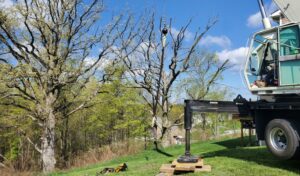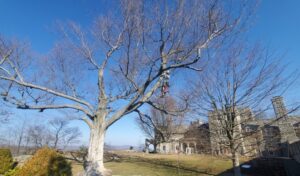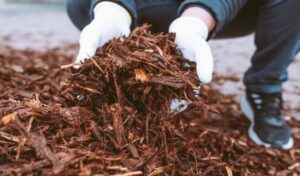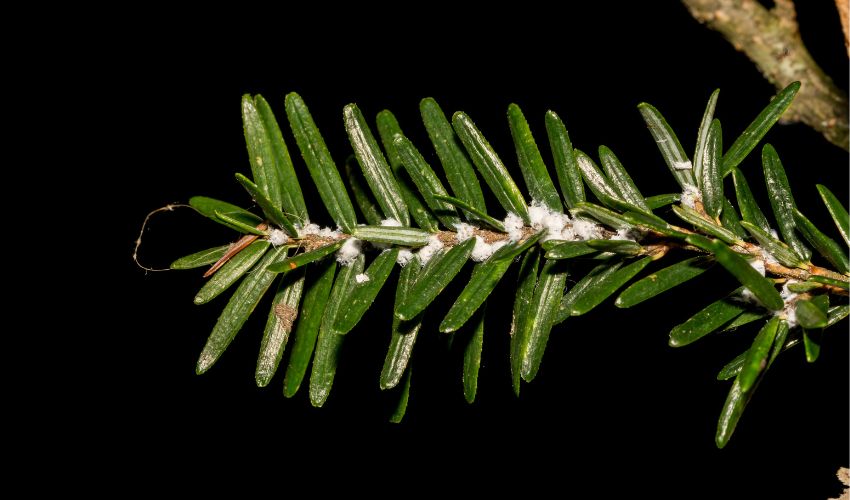
Hemlock Wooly Adelgid (HWA) is a pest that is killing many hemlock trees in New York and throughout the Northeast United States.
This pest is tiny but is most easily spotted during the winter months. It can best be seen as white cotton-like dots on hemlock tree needles or twigs from October through May.
In this article, we’ll show you how to spot hemlock wooly adelgid on your hemlock trees, some information on why this pest is so destructive, what to do if you spot it on your trees, and more.
Do You Have Hemlock Trees?
Hemlock wooly adelgid only impacts hemlock trees, so the first step is to identify if you have any hemlock trees on your property.
Hemlocks are cone-producing evergreen trees that can grow over a hundred feet tall over the course of 250 to 300 years. You can spot a hemlock tree by its flat needles and tall size.
Hemlock needles are around a half-inch long, flat with a rounded point, and have pale white stripes on the underside of the needles.
How to differentiate hemlock trees from other similar trees >>
The name “hemlock” is reportedly due to the fact that the needles, when crushed, have a scent similar to the herb hemlock, a poisonous plant native to Europe.
There are two types of hemlock trees that are susceptible to HWA in New York state, Eastern Hemlock (Tsuga canadensis) and Carolina Hemlock (Tsuga caroliniana).
The Importance of Eastern Hemlock Trees in New York
The Eastern hemlock is the most common type of hemlock tree throughout New York.
These normally long-lasting trees are important in both forests and urban areas, as they provide not only food and shelter for wildlife but also a shaded and cool ecosystem in which plants can grow, streams are kept cool, and habitats are created.
Learn more about eastern hemlock trees >>
How to Spot Hemlock Wooly Adelgid
Once you’ve determined that you do have hemlock trees on your property, the next step is to check for signs of hemlock wooly adelgid.
Check for White Spots on the Underside of Hemlock Branches
The HWA itself (Adelges tsugae) is similar to an aphid but is so small (usually 2mm in size) that it is tough to spot. During the winter, however, the adelgids create white “wooly” wax clusters. These clusters are on the branch at the point where the needle grows. These white fluffy masses are smaller than a cotton swab and are created by the female adelgids in late winter.
Check for these white growths on the underside of branches, starting with any new growth on the tree, from October through May.
The rest of the year, HWA appears small and black (it has been compared to a black sesame seed), and surrounded by a smally thin circle of the white wool-like substance.
Watch for a Lack of New Buds, Gray Needles, or Dead Branches
In late spring and early summer, a lack of new buds can also signal the presence of HWA on your tree.
Finally, needles that are turning gray or dropping or entire limbs dying can be evidence that your tree is suffering from an HWA infestation.
Note: Spider egg sacs, spittlebugs, dried sap, and scale insects can look like a hemlock wooly adelgid issue, but there are clear differences.
How does Hemlock Wooly Adelgid Harm Trees?
Trees infested with hemlock wooly adelgid will die within four to ten years. HWA is an invasive pest, native to Japan. In Japan, there are native predators of the hemlock wooly adelgid that control it, but here in the U.S. it spreads with little native control, killing many hemlock trees throughout the country.
HWA was discovered in New York in the 1980s and continues to plague and kill hemlock trees throughout our state. Those infected can show significant needle and twig loss within two years.
The aphid-like insect, hemlock wooly adelgid, has a piercing mouthpart that it inserts into the tree twig and enables the adelgid to suck out the inside like a straw. Unlike some insects that feed on the tree’s sap, HWA feeds directly from the tree’s storage cells.
The tree responds to this invasion by walling off the cells where the mouthpart has infiltrated, eventually leading to the death of needles and then entire twigs and branches of the tree.
Hemlock wooly adelgids attach themselves to a tree, usually at the base of a hemlock needle, insert their mouthparts, and stay in that spot for the rest of their lives.
The wooly wax that surrounds them acts as a protectant for themselves and for any eggs that the females may produce. One female adelgid can produce 200 eggs.
Those eggs hatch, mature, and the females produce eggs themselves. According to the New York Invasive Species Information website, that can lead to 40,000 eggs in one year, started by one female and her 200 eggs.
Learn more about HWA from the New York State Hemlock Initiative >>
What to do if Your Tree has Hemlock Wooly Adelgid
If you spot HWA on your tree or want to prevent it from infecting your hemlock trees, you have a few options.
Schedule Horticultural Oil Treatments
Horticultural oil, applied in spring and fall, can suppress adelgids and prevent damage to your hemlock trees. This natural oil can be great at preventing pest issues before they can do too much damage.
They can be especially beneficial on young trees when the entire tree is able to be covered with horticultural oil.
Horticultural oils are also used to suppress scale insects, mites, and other insect pests on a variety of trees and shrubs.
Learn more about our tree disease and insect treatments >>
Schedule Other Tree Pest Treatments
Specific insecticides may sometimes be used to target hemlock wooly adelgid. The use of a pesticide varies and may not be effective for your tree or property.
Some pesticides, especially those not targeted for specific pests or applied by someone other than a certified pesticide applicator, can harm other insects or wildlife, including the insects that are natural predators of the HWA.
Soil drench methods may be used to apply insecticides that target hemlock wooly adelgids.
For the best and most effective results, contact Hill Treekeepers to schedule a plant health care consultation.
Keep Your Trees Healthy
Stressed trees are more prone to diseases and infesting infestations. One simple way to care for your trees is to keep them healthy.
You can do this by watering during times of drought, professionally pruning any dead or dying branches, and ensuring any new hemlock trees purchased are inspected for hemlock wooly adelgid before bringing them to your property.
Learn more about how to prevent and treat pests and diseases >>
Contact Hill Treekeepers to Keep Your Trees Healthy
If you have hemlock trees on your New York property, they are highly susceptible to hemlock wooly adelgids and the damage they cause.
Contact Hill Treekeepers to schedule an arborist consultation, where we can confirm if you have hemlock trees, check for signs of hemlock wooly adelgid, and suggest any preventative care or treatments needed.
The experts at Hill Treekeepers can also keep your other trees and shrubs healthy. While HWA is a big issue in our area, it’s not the only pest or disease impacting our local landscapes.
Contact Hill Treekeepers for a Tree Health Care estimate today.
Share this online!
Get the highest quality of tree services for residential and commercial properties in the Hudson Valley area. We look forward to working with you!
TOPICS
Recent Articles
Don't Miss the Next Update!
Join the thousands of smart Hudson Valley residents who get the monthly newsletter from Hill Treekeepers. It's full of helpful information you won't want to miss!

